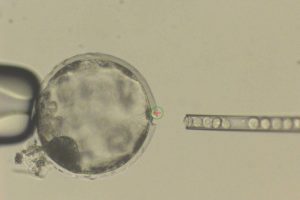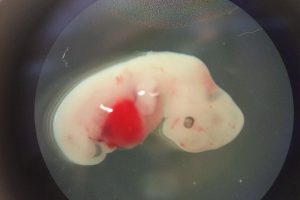A pig might just save your life
An End to the Wait? Human-Pig Hybrid Creates Hope for the End of Organ Donation
By Caroline Soper
The Answer: 22 people die every day while waiting for this. (The question to this answer will be revealed at the end of this article. No cheating!)
“Everyone should know this stuff” level
What if we lived in a world where organ donation was no longer needed? Where patients on the waiting list would no longer have to worry about whether or not their life would be saved because of someone else’s ending? Luckily for us, this may not be too far off.
The concept of a chimera has been around for thousands of years. Part lion, goat, and snake, it was a mythical creature that breathed fire that was an omen for disaster. Nowadays, the term chimera has been used to describe anything that is a hybrid of two or more animals. It is this chimera that could potentially save thousands, or eventually even millions of lives.
Chimeras in the scientific community are commonly hybrids of things like a mouse and a rat, or a human and a pig. Chimeras are usually developed by taking embryos of one species and injecting cells of another into the embryo in very early stages of development. This is tricky, as you need to get the timing of both the embryo and the stem cells just right in order to produce a viable organism, however it has been proven to be possible in some cases.
The second technique for producing chimeras is executed by taking organs from one organism; say taking a heart from a rat and putting it in a mouse’s chest. This second method, while it might seem potentially easier than developing these organisms from scratch, is actually the less effective of the two, and sees far more cases of infection and death when tested.
In the past few decades, there has been a steady flow of chimeras within the medical community that has been largely overlooked: humans with animal organs inside them. While this may sound like something out of a Frankenstein movie, it is actually quite common. There are many people who have had porcine or bovine valves implanted into their hearts as a way to replace their own valves that are not functioning properly. But recently, there has been a push to go further. To create viable organs that are engineered specifically for patients, eliminating the need for human organ donors and waiting lists. This is where the most intriguing development in the field of chimeras has come about.
“For geniuses only” level
Recently, a study was published by a team led by Juan Carlos Izpisua Belmonte, a scientist at the Salk Institute for Biological Studies, that showed their teams success with introducing human stem cells into early stage pig embryos.
Their study contained 1,400 pig embryos that were injected with one of three kinds of human stem cells: normal human cells, cells that were ready to develop into organs or tissue but had not yet done so, and “intermediate” cells that were not quite ready for development and were not normal. (Blakemore, 2017) All three kinds of human cells had been transformed, so that they would express GFP, a green fluorescent protein, which would help scientists identify them later in their studies of the embryos. Once the scientists had injected the embryos with the human cells, they allowed them to develop for three to four weeks before removing them from the pigs that were carrying them in order to observe the development of the embryos. (Blakemore, 2017)

A pig blastocyst being injected with human stem cells. PHOTOGRAPH COURTESY JUAN CARLOS IZPISUA BELMONTE (Blakemore, 2017)
Belmonte and his team discovered upon observation, that the embryos that had been injected with the intermediate cells were the most successful and developed the most human cells during gestation. This finding shows that most other studies that had attempted to introduce human stem cells into animal embryos were most likely using stem cells at the wrong stage of development. (Blakemore, 2017)
That being said, only 1 in 100,000 cells in the embryo was human, meaning that these chimeras, while a hybrid, were still primarily composed of pig cells. In total, there were 186 later stage chimeric embryos that survived during the entire experiment. (Blakemore, 2017)

A human-pig chimera in week four of development. PHOTOGRAPH COURTESY JUAN CARLOS IZPISUA BELMONTE (Blakemore, 2017)
Due to the success of the experiment conducted by Belmonte and his team, many other scientists are beginning to think of the possibilities that chimeras hold. The chimeras, while an early success, need quite a lot of development before they will be able to save lives, which is where other scientist have begun to ask their own questions about how to improve his technique. The human cell count of the chimera needs to dramatically increase in order to produce organs that will be compatible with the human body and immune system. In addition to the cell count, many people are worried about how to eradicate viruses that lie dormant in pigs, but could be activated once introduced to a human host.
Many scientists agree that while this development is the first step into solving the problem of organ donation, there is still a long way to go. Belmonte and his team are hoping to continue working with the chimeras to study disease transmission and early embryonic development. So while this is a major breakthrough, don’t count on receiving a new kidney from a pig anytime soon.
Impress your friends and family with these three related facts:
Fact 1: Kidneys are the most commonly transplanted organ in the world. (“Organs &”)
Fact 2: The organs that can be donated are: kidneys, heart, liver, lungs, pancreas, small bowel, corneas, blood/ plasma, and tissue (bone, skin, marrow, etc.). (“Organs &”)
Fact 3: The first organ donation was between two identical twins in 1954, and it was a kidney. (History of Organ)
The Question: How many people die every day waiting for an organ transplant?

Caroline Soper is a senior at Choate Rosemary Hall. Her spirit animal is a manatee, and one day she will be famous for playing a concerto on a squash racquet.
Still interested? Click here to hear more about a different kind of chimera.
Works Cited:
Blakemore, E. (2017, January 26). Human-Pig Hybrid Created in the Lab—Here Are the Facts. National Geographic. Retrieved from http://news.nationalgeographic.com/2017/01/human-pig-hybrid-embryo-chimera-organs-health-science/
History of Organ Donations & Transplants. (n.d.). Retrieved February 28, 2017, from LiveOnNY website: http://www.liveonny.org/all-about-transplantation/organ-transplant-history/
Organs & Tissues for transplant. (n.d.). Retrieved February 28, 2017, from LifeCenter Northwest website: http://www.lcnw.org/donation/organs-tissues-for-transplant/
Reardon, S. (n.d.). Hybrid zoo: Introducing pig–human embryos and a rat–mouse. Nature. http://dx.doi.org/10.1038/nature.2017.21378
Reardon, S. (2015). New life for pig-to-human transplants. Nature, 527, 152-154. http://dx.doi.org/10.1038/527152a

Leave a Reply